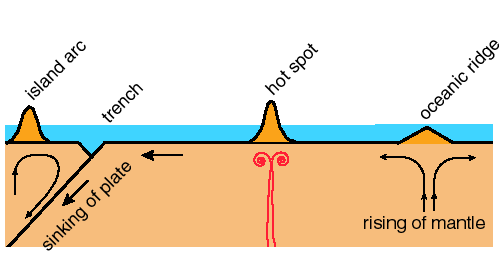  Top of Part 5
Top of Part 5
  Previous p.
Previous p.
  Next page
Next page
|
 The surface of the solid earth The surface of the solid earth
 is covered by more than 10 plates is covered by more than 10 plates
 which are about 100km thick. which are about 100km thick.
 The crust is, so to speak, The crust is, so to speak,
 put on these plates. put on these plates.
 A plate is newly produced A plate is newly produced
 by the mantle rising by the mantle rising
 at an oceanic ridge, at an oceanic ridge,
 and it sinks down and it sinks down
 and disappears into the mantle and disappears into the mantle
 at a trench. at a trench.
 (See Figure below.) (See Figure below.)

 An oceanic ridge is, An oceanic ridge is,
 so to say, a huge crack so to say, a huge crack
 in the crust, in the crust,
 which forms a very which forms a very
 long chain of mountains, long chain of mountains,
 for example, for example,
 under the Pacific Ocean, under the Pacific Ocean,
 the Atlantic Ocean the Atlantic Ocean
 and the Indian Ocean. and the Indian Ocean.
 At these oceanic ridges, At these oceanic ridges,
 the plate is divided right and left, the plate is divided right and left,
 and accordingly hot and accordingly hot
 mantle comes up from the depths. mantle comes up from the depths.

 A trench is a very, A trench is a very,
 very deep ditch under the sea water. very deep ditch under the sea water.
 The plate sinks down The plate sinks down
 at this trench into the mantle at this trench into the mantle
 because of its own weight. because of its own weight.

 The motion of a plate The motion of a plate
 is very slow; is very slow;
 i.e., several cm/year i.e., several cm/year
 or 10cm/year at most. or 10cm/year at most.
 Plate tectonics is Plate tectonics is
 a theory (or logic) a theory (or logic)
 to explain the seismic to explain the seismic
 and volcanic activities and volcanic activities
 and the formation of large chains and the formation of large chains
 of mountains on the earth. of mountains on the earth.

|

 Top of Part 5
Top of Part 5

 Previous p.
Previous p.

 Next page
Next page
 The surface of the solid earth
The surface of the solid earth
 is covered by more than 10 plates
is covered by more than 10 plates
 which are about 100km thick.
which are about 100km thick.
 The crust is, so to speak,
The crust is, so to speak,
 put on these plates.
put on these plates.
 A plate is newly produced
A plate is newly produced
 by the mantle rising
by the mantle rising
 at an oceanic ridge,
at an oceanic ridge,
 and it sinks down
and it sinks down
 and disappears into the mantle
and disappears into the mantle
 at a trench.
at a trench.
 (See Figure below.)
(See Figure below.)

 An oceanic ridge is,
An oceanic ridge is,
 so to say, a huge crack
so to say, a huge crack
 in the crust,
in the crust,
 which forms a very
which forms a very
 long chain of mountains,
long chain of mountains,
 for example,
for example,
 under the Pacific Ocean,
under the Pacific Ocean,
 the Atlantic Ocean
the Atlantic Ocean
 and the Indian Ocean.
and the Indian Ocean.
 At these oceanic ridges,
At these oceanic ridges,
 the plate is divided right and left,
the plate is divided right and left,
 and accordingly hot
and accordingly hot
 mantle comes up from the depths.
mantle comes up from the depths.

 A trench is a very,
A trench is a very,
 very deep ditch under the sea water.
very deep ditch under the sea water.
 The plate sinks down
The plate sinks down
 at this trench into the mantle
at this trench into the mantle
 because of its own weight.
because of its own weight.

 The motion of a plate
The motion of a plate
 is very slow;
is very slow;
 i.e., several cm/year
i.e., several cm/year
 or 10cm/year at most.
or 10cm/year at most.
 Plate tectonics is
Plate tectonics is
 a theory (or logic)
a theory (or logic)
 to explain the seismic
to explain the seismic
 and volcanic activities
and volcanic activities
 and the formation of large chains
and the formation of large chains
 of mountains on the earth.
of mountains on the earth.

